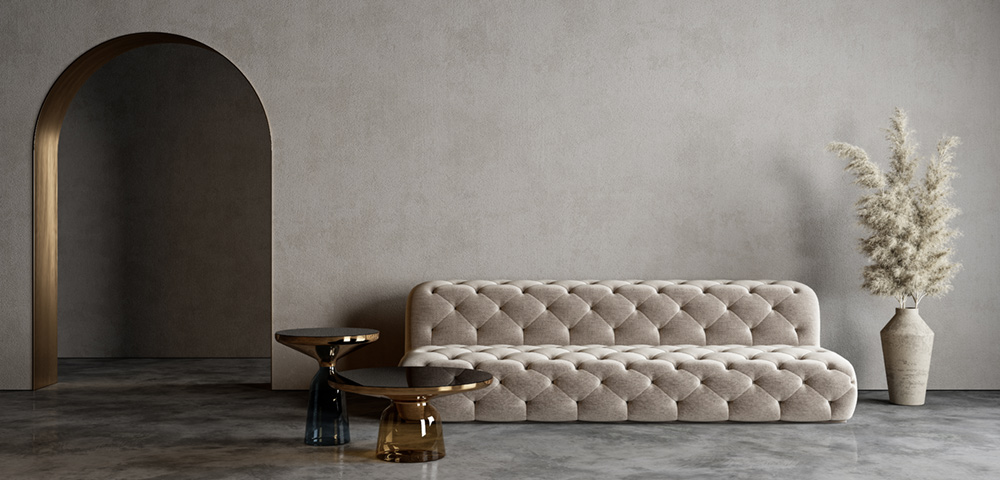Design Dictionary: Your Guide to 16 Essential Interior Design Terms
By lodha
January 10, 2024The journey of designing your own home is a delightful experience where your style and personality can take centre stage. However, the world of interior design is inclusive of creativity, aesthetics and functionality that converge to craft spaces that inspire, comfort and reflect the unique taste of their inhabitants. Yet, for those new to this, it can sometimes feel like navigating through a foreign land filled with a myriad of jargon and unfamiliar terminology.
Fear not, for this we've curated a comprehensive interior design dictionary, comprising 16 indispensable interior designing meanings and interior design-related words that every aspiring designer, homeowner or anyone with an interest in crafting exquisite living spaces should acquaint themselves with.
1. Proportion

Proportion is the relationship between the size and scale of various elements within a room. It ensures that furniture, decor and architectural features are appropriately sized about one another and to the overall space. Proper proportion contributes to a balanced and harmonious interior.
2. Minimalism

Minimalism is a design style characterized by simplicity and the removal of excess elements. In minimalist interiors, there is a focus on essential elements, clean lines and a sense of spaciousness. Minimalist spaces often employ a neutral colour palette, uncluttered surfaces and a "less is more" philosophy.
3. Open Plan

An open plan design is an architectural layout that eliminates walls or partitions between different functional areas within a space, such as the kitchen, dining and living areas. This design fosters a sense of spaciousness, promotes natural light flow and encourages interaction among occupants.
4. Mid-Century Modern

Mid-Century Modern is a design style that emerged in the early 1900s. It emphasizes simplicity, clean lines, functionality and the use of organic shapes. This style often incorporates iconic furniture pieces from that era, creating a timeless and retro-modern look.
5. Vastu/Feng Shui

Vastu or Feng Shui are ancient design philosophies that consider the arrangement and placement of elements within a space to promote harmony, balance and positive energy flow. Vastu is Indian and Feng Shui is Chinese, and both focus on principles of spatial organization, orientation, and symbolism.
6. Monochromatic

The monochromatic design revolves around using variations of a single colour throughout a space. It creates a sense of simplicity and unity while allowing for depth and interest through different shades, tones and tints of the chosen colour.
7. Earthy Tones

A palette inspired by nature, earth tones include warm browns, deep greens, and muted terracottas, creating a grounded and calming ambience.
8. Biophilic Design

Embracing nature indoors, biophilic design integrates natural elements like plants and sunlight, promoting well-being and connectivity with the environment.
9. Grandmillennial

Blending traditional elements with a modern twist, the grandmillennial style embraces vintage patterns, classic furniture and a touch of nostalgia.
10. Wabi-Sabi

Rooted in Japanese philosophy, wabi-sabi celebrates imperfections, embracing the beauty of age, wear and authenticity in design.
11. Focal Point

A focal point is a visually dominant element in a room that immediately draws attention and becomes a centre of interest. It serves as a key feature around which the design revolves, creating a cohesive and balanced look.
12. Accent Pieces

Accent pieces refer to decorative items or furniture that stand out and add visual interest to a space. These elements are strategically placed to complement the overall design, providing a pop of colour, texture or style.
13. Dado

Dado is a design term used to describe the lower portion of a wall that is adorned with decorative panelling, wallpaper or paint. It typically extends from the floor to about chair-rail height and contributes to the overall aesthetic of the room.
14. Skirting

Skirting, also known as baseboards, is a protective and decorative moulding installed along the bottom of a wall where it meets the floor.
15. Upholstery

Upholstery is the materials, padding and fabric covering used to make and furnish furniture, particularly seats and sofas.
16. Bohemian

Bohemian embodies a free-spirited, unconventional lifestyle and design aesthetic, characterized by eclectic patterns, vibrant colours and a mix of cultural influences that celebrate individuality and creativity.
Now that you're armed with these fundamental interior design synonyms and interior-related words, you're better equipped to dive into the world of decorating and design. Whether you're looking to transform your own space or embark on a career in this field, mastering these interior design-related words will set you on the path to creating stunning, functional and harmonious spaces that reflect your unique style.
You may also like



 Enquire
Enquire
 Call
Call
 chat
chat
 Search
Search





